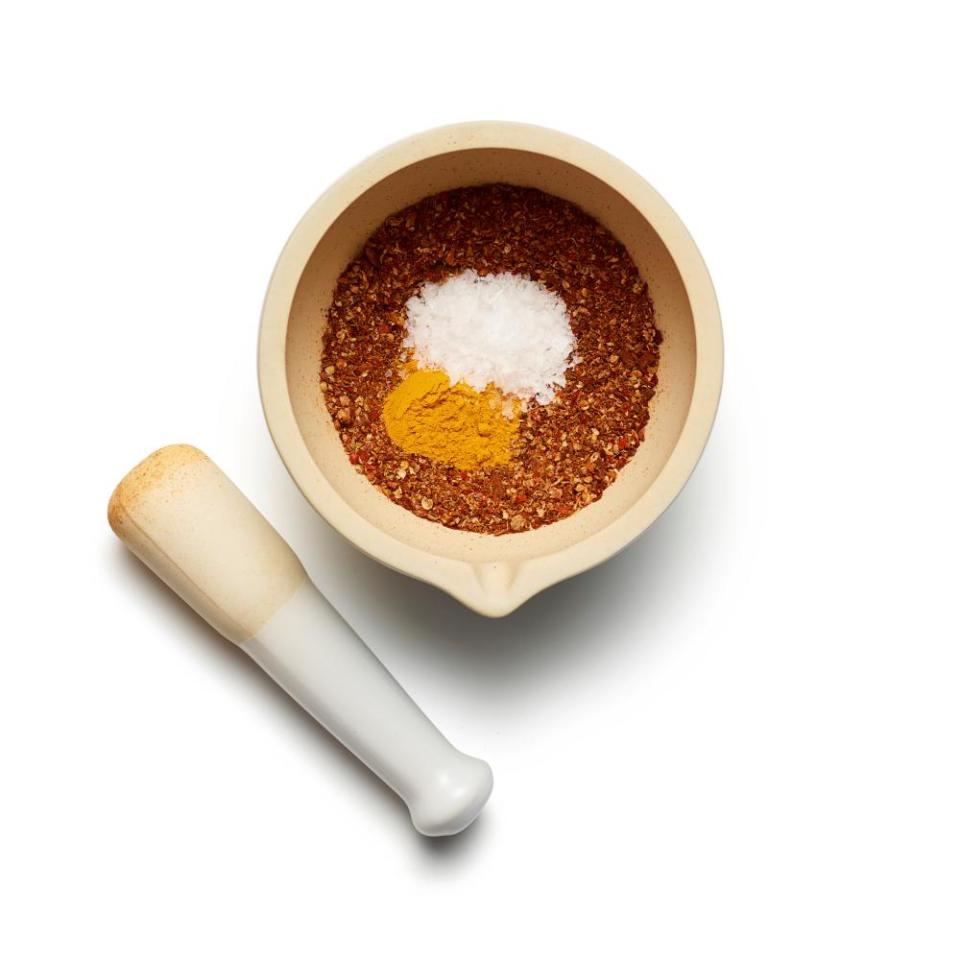How to make Goan seafood curry – recipe
One of the world’s great fish dishes, Goan-style seafood curry is, like the region’s infamous vindaloo, spicy in the truest sense: deeply aromatic, rather than merely hot, with chillies playing second fiddle to the almost mentholated sweetness of cloves and star anise. Refreshingly tangy, thanks to the local fondness for vinegar, it’s perfect warm-weather fare.
Prep 15 min
Cook 35 min
Serves 4
For the masala
1 tsp cloves
1 tbsp coriander seeds
1 tsp cumin seeds
8 dried red Kashmiri chillies
2 star anise
½ tsp turmeric
1 tsp salt
5 garlic cloves
3cm piece fresh root ginger
1 tbsp palm sugar (see step 2)
1½ tbsp white vinegar
For the curry
1 onion
3 tbsp vegetable oil
1 large tomato
1 x 400ml tin coconut milk
2 fresh green chillies
400g firm white fish (eg, pollock)
200g prawns (shelled weight, see step 6)
½ tsp mustard seeds
10 curry leaves
Coriander leaves, to garnish
1 Start on the spice mix

For the masala, or spice mix, toast the cloves, coriander and cumin seeds, dried chillies and star anise in a hot, dry frying pan until you can really smell them, then crush them to a powder in a mortar or spice grinder. Stir in the turmeric and salt.
2 Finish the masala
Peel and crush the garlic cloves, and peel and finely grate the ginger, then stir both into the spice mix, along with the sugar – if your palm sugar comes in a solid block, crush this in the mortar, too (if you can’t find palm sugar, soft brown sugar makes a decent, though not exact, substitute). Finally, stir in the vinegar to make a smooth paste.
3 Start on the curry base
Peel and finely chop the onion. Heat two tablespoons of the oil in a large, wide pan over a medium heat, then gently saute the onion until soft and lightly golden, stirring to make sure it doesn’t catch and burn. Meanwhile, grate the tomato, discarding the skin (don’t worry about any small bits that get into the pulp).
4 Add the spices and tomato
Add the masala mix to the pan and cook, stirring, for a couple of minutes, until you can smell the spices again (be careful not to get too close: hot vinegar can irritate the eyes!), then stir in the grated tomato and continue to cook until most of the liquid has evaporated and the pan is fairly dry.
5 Add the liquids and chillies
Slowly add the coconut milk, stirring it in gradually to make a smooth gravy, then repeat with 100ml cold water. Slit the fresh chillies down their length, so they remain whole but open, add these to the pan, too, and bring to a boil. Turn down the heat a little, then leave to simmer for about 10 minutes, until the gravy has slightly thickened.
6 Get the seafood ready
Meanwhile, prepare the fish and seafood. As long as you have enough for four people, you can use just about anything you fancy in this dish, but I like to go for a mix of firm white fish, such as pollock, and prawns for their nutty sweetness. Cut the fish into roughly 2cm chunks, removing any skin, and shell the prawns, if need be (or use whole large ones, if you prefer – two per person, say).
7 Add the seafood to the curry
You can make the dish up to this point ahead of time if you like, but don’t add the fish and seafood until you’re ready to eat, otherwise it will be tough and overcooked if reheated. Taste the sauce, adjust the seasoning, if necessary, then drop in the fish and seafood, and cook gently for about five minutes, until translucent.
8 Now for the temper
Meanwhile, make the tadka, or tempered oil, to finish the dish. Heat the remaining oil in a small frying pan on a high heat, then add the mustard seeds and curry leaves.
Cook for 30 seconds, until the seeds begin to pop, then stir into the curry pot. Top with a little chopped coriander and serve with steamed rice.
9 Variations on the theme
This gravy is very versatile: substitute the fish and seafood for vegetables of your choice (pre-cooked first, if they won’t be done in five minutes) or chunks of firm tofu, or paneer, or even hard-boiled eggs. Aubergines and summer squash would be delicious choices, as would green beans, fennel or cauliflower. Cooked chicken would also be good.

 Yahoo News
Yahoo News 
